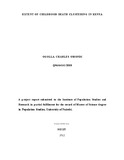| dc.contributor.author | Ogolla, Charles O | |
| dc.date.accessioned | 2013-02-26T08:00:08Z | |
| dc.date.available | 2013-02-26T08:00:08Z | |
| dc.date.issued | 2012 | |
| dc.identifier.uri | http://erepository.uonbi.ac.ke:8080/xmlui/handle/123456789/11390 | |
| dc.description.abstract | This paper aimed at examining the extent' of childhood death clustering in families in Kenya and uses the findings in informing policy makers for effective program planning and policy interventions on issues regarding child survival programmes. The study sought to assess the extent of clustering of infant and child deaths in rural and urban Kenya and also identify how socio-econontic factors such as maternal education and wealth Index are associated with the concentration of infant and child deaths in families. This study adopted a modified version of Mahadevan (1986) model of studying child survival. the adoption of this model and not the others such as Mosley and Chen 1984) was due to the fact that Mahadevan un like The Mosley and Chen has concepts and terminologies that are specifically related to mortality which is very important since it avoids the confusion that anses when using the term 'intermediate' and 'Proximate' Determinants , which are more related to fertility. Instead , Mahadevan has developed terms like 'Life Affecting Variables' to specifically refer to the mortality determinants.
Furthermore Mahadevan model IS flexible and enjoys more advantages that has even made it more appropriate for this study. It incorporates both micro and macro variables whose influence on the health and consequent death of the child is diverse. This model clearly recognizes the fact that several LA V's either in similar or is similar manner influence mortality in any society. it is thus this element of dissimilarity that made the model more appropriate for this study
The study use data from KDHS 2008/09 which involved a nationally representative sample of 8444 women in their reproductive ages. Where 6102 women had parity one and above with total live births of 22534. To look at the existence and extent of child death clustering theoretical Binomial distribution Poisson and Negative binomial statistical distributions namely distributions were utilized. The results confirmed that clustering depends on area of residence, maternal education and Wealth index. The existence of death clustering and its variation suggest that new ways of identifying such families need to be examined to specifically utilize targeted programs. | en_US |
| dc.language.iso | en_US | en_US |
| dc.publisher | University of Nairobi, Kenya | en_US |
| dc.title | Extent of childhood death clustering in Kenya | en_US |
| dc.title.alternative | Thesis (MA) | en_US |
| dc.type | Thesis | en_US |

